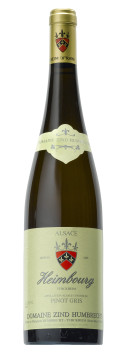
Technical presentation
| Bottling : | September 2006 |
|---|---|
| Acquired alcohol : | 14.9° |
| Residual sugar : | 30.0 g/l |
| Total acidity : | 3.8 g/l H2SO4 / (5.8g/l Tartrique) |
| pH : | 3.5 |
| Yield : | 21 hl/ha |
| Average age of vines : | 20 years |
| Grape variety : | Pinot Gris |
| Terroir : | Heimbourg |
| Sweetness index : | 3 |
| Soil : | Marl-Oligocene calcareous, West North West facing |
Description of the wine Pinot Gris Heimbourg 2005
This vineyard enjoyed similar conditions as the Rotenberg in 2005. The botrytis took it in way that it was almost impossible not to make an SGN! The very few berries left healthy produced a semi dry wine after two months struggle for the yeast to ferment as much sugar as I could have hoped for. The Pinot Gris is planted in the highest part of the Heimbourg. The vines are exposed to more wind, excellent in drying the botrytis, but also struggling to grow on a shallower soil, reducing the yields dramatically.

Tasting notes
01/2007 : The fermentation was actually very powerful. The nose feels more mineral, stony, and the long lees contact influence is still very strong. This wine is clearly showing a lot on the nose now, but experiments show that it is at its best almost a week after being open. The palate has the entire rigor expected from a calcareous soil: acidity, power and a certain austerity that stops the sweetness of being to easy.

The Heimbourg of Turckheim
The wines produced on the Heimbourg are rich, opulent, often spicy and can include noble rot. The slower ripening of the grapes often produces wines that are aromatically expressive from a young age, contrary to its neighbour the Clos Jebsal with whom we have to show patience.